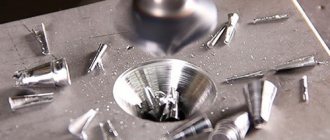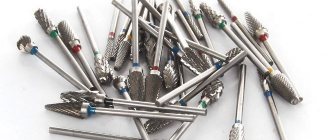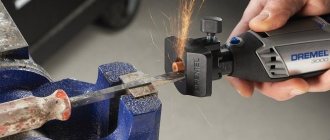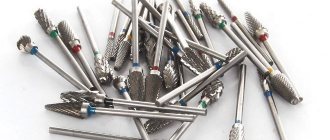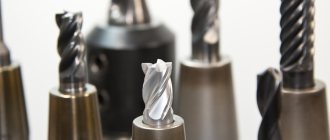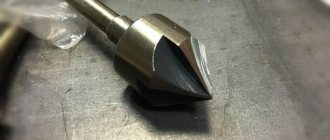- home
- Information
- Articles
- Countersinks and countersinks, application and differences
Back to list
Several types of tools are used to process holes, including countersinks, countersinks, and counterbores. The practice of their use is often accompanied by confusion in the names. For example, in tender documentation there are orders for “conical countersinks”, and GOST 14953-80 is indicated, which describes conical countersinks. These tools are similar in design, and there is also much in common in application, so it is not surprising that even in the technical literature there are many examples of “free” use of terminology.
Official source on the terms GOST 25751-83 “Cutting tools. Terms and definitions,” unfortunately, does not answer the questions: what is the difference between a countersink and a countersink, countersinking and countersinking and countersinking. To this end, we will consider the design and application of each of these tools.
Countersink
What is the difference between countersinking and countersinking? Although they sound similar, they are different operations. Each has its own purpose and a specific tool for execution.
What is countersinking? It involves cutting off a larger layer of material in order to create a conical or cylindrical recess in the upper part of the hole, intended for hidden installation of fasteners. Countersinking is also used to select chamfers. A special device for performing this operation is called a countersink. The following types are distinguished:
- cylindrical, used to make cylindrical recesses at the top of the hole to hide the heads of screws or nuts;
- conical, with their help they cut out a cone-shaped recess in the lower part of the hole, chamfer and form recesses for fasteners.
- end, also called counterbore, such a tool is needed for cleaning out recesses before installing fasteners.
Structurally, the countersink consists of two parts: the working head and the shank. A guide pin is provided on the shank, ensuring alignment of the selected recesses.
A drilling machine is usually used as equipment along with countersinks. Less commonly, they are clamped into the chuck of a multi-axis machining center or a simple lathe. Drills and other hand-held drilling tools are not recommended for use as they cannot provide proper alignment and accuracy.
Countersinking is the processing of the inner surface of a hole to improve its quality.
- accuracy;
- roughness;
- forms.
Countersinking is used to process holes made by drilling, stamping or casting. A countersink is used to perform the operation. It resembles a drill, but differs from it in the following ways:
- a large number of cutting edges;
- thickened bridge between edges;
- beveled corner.
These design features determine the stability of the position of the countersink relative to the hole and their coaxiality. The countersink does not deepen the hole, but only improves the smoothness and shape of the surface, removing a very thin layer of material.
Countersinks have from six to eight cutting edges; small diameter tools (up to 20 mm) are made in one piece, while larger ones have inserted blades.
Countersink
Countersink
Metal processing by countersinking is similar to drilling - this is the rotation of a countersink around its axis. When countersinking, the hole is improved to 9-11 accuracy grades. Also, with the help of a countersink, the roughness of the hole is improved to Rz 2.5 microns.
Main purposes of the countersink:
- Calibration of ready-made holes for fasteners (bolts, studs)
- Improving hole quality before tapping or using a reamer.
Countersinking is not done using a conventional drill or any other manual method. After all, the purpose of this operation is aimed at improving the quality of the hole, which is almost impossible to do with a drill. Therefore, countersinking is performed using a machine tool using drilling, turning, and milling machines.
If we divide countersinks into groups, then in metalworking there are two groups according to accuracy:
- Countersink number 1 - Mainly used for semi-finishing as preparatory work before reaming or cutting threads.
- Countersink with number 2 - Used for final work. Has a relatively high accuracy class H11
According to the design, two types of countersinks are used - solid and mounted (disassembled). If we talk about solid ones, they are used more often, and they have a cone-shaped end. It has a groove for chip removal and cooling and cutting teeth. If we talk about mounted countersinks, their design is distinguished by a removable tip, which is attached through an internal hole.
There are also countersinks that are used much less frequently, in special cases. Namely, these are countersinks with welded plates made of the hardest metal, welded or prefabricated countersinks.
The material from which the countersink tip is made
In solid countersinks, P18 or P19 steel is used to make the cutting teeth. If a countersink is made for processing carbide metals, then its teeth are made of metal-ceramic alloys VK4, VK6 or VK8. If steel products are to be processed - T15K6
Types and application of countersinks
Depending on the purpose, countersinks are divided into the following types:
- for making conical or cylindrical recesses inside holes;
- to create reference planes rippled with a hole;
- for chamfering;
- to prepare holes for installation of fasteners.
Based on the shape of the working surface there are:
- cylindrical;
- conical;
- end or straight.
Depending on the diameter, countersinks are divided into:
- regular (0.5 ÷ 1.5 mm);
- with limiter cone (0.5 ÷6 mm);
- with a cone-shaped shank (8÷12 mm).
For the reaming operation, a combined device is used, which includes a drill, a reamer, a countersink and a countersink. They are mounted on a common shank, and the working surfaces are spaced apart in height and come into contact with the metal in turn, as the tool is immersed in the material. The use of such a combined tool allows you to drill a hole, make chamfers, and improve the quality of the surface in one technological pass. This saves a lot of time on changing tools and ensures the accuracy of the dimensions of each structural element. Such a device is expensive and is assembled anew for each hole size, so its use is economically justified only for mass production or for a product with a large number of identical holes of a complex configuration.
How to choose the countersink size?
In order for the screw to fit perfectly into the countersunk, it is important to select the correct conical countersink for the head of the hardware and countersink the hole to an exact depth equal to the height of the head. The angle of the tool must correspond to the angle of the head cone, and its diameter must correspond to the diameter of the head. If you take a countersink that is too large, the head will sink into the “crater” of the hole, and if it is smaller, then it will protrude above the plane, which also does not look aesthetically pleasing.
The GOST 12876-67 standard specifies the dimensions of the supporting surfaces for fasteners with countersunk and semi-countersunk heads. Based on this data, we have compiled a table that will help you quickly determine which countersink is suitable for a particular screw thread diameter.
Table 1. Countersink size for the screw head (including tolerances).
| Thread diameter d, mm | Standard head sizes | Countersink diameter, mm | Maximum deviations, mm | ||||
| Diameter, mm | Height, mm | D1 (to H13) | D2 (by H12) | D3 (to H14) | |||
| 2.0 | 3.8 | 1.2 | 4.3 | 4.6 | 4.3 | — | |
| 2.5 | 4.7 | 1.5 | 5.6 | 5.7 | 5 | — | |
| 3 | 5.6 | 1.65 | 6.3 | 6.6 | 6 | 7 | |
| 3.5 | 6.5 | 1.93 | 7.3 | 7.6 | 7 | — | |
| 4 | 7.4 | 2.2 | 8.3 | 8.6 | 8 | 9 | |
| 5 | 9.2 | 2.5 | 10.4 | 10.4 | 10 | 11.5 | |
| 6 | 11 | 3 | 12.4 | 12.4 | 11.5 | 14.5 | |
| 8 | 14.5 | 4 | 16.5 | 16.4 | 15 | 18.5 | |
| 10 | 18 | 5 | 20.5 | 20.4 | 19 | 22 | |
| 12 | 21.5 | 6 | 24.0 | 24.4 | 23 | 26 | |
| 14 | 25 | 7 | 28.0 | 28.4 | 26 | — | |
| 16 | 28.5 | 8 | 31.0 | 32.4 | 30 | — | |
| 18 | 32.5 | 9 | 35.0 | 36.4 | 34 | — | |
| 20 | 36 | 10 | 39.0 | 40.4 | 37 | — | |
Design
The conical countersink has two main structural parts:
- a shank designed for attaching a countersink to the chuck of a drilling or lathe;
- a working body for countersinking holes, consisting of 6 ÷ 12 cutting edges of increased thickness (compared to a drill.
The cone sweep angle is from 60 to 120°. The number of edges depends on the diameter of the tool; the larger it is, the more edges there are.
A cylindrical countersink is structurally similar to a drill, but has a larger number of cutting edges. Their length, unlike a drill, is limited by the diameter of the cylinder, since the countersink makes only small recesses in depth.
At the end there is a guide pin that ensures fastening in the chuck. A removable belt can be installed behind the ends of the cutting edges, limiting the depth of immersion into the workpiece. The limiter can be designed as a non-removable part of the countersink. If necessary, a cutting attachment is mounted on the countersink. When depicting a hole in a drawing, the type and size of the countersink is indicated next to it or in an explanatory note in the margin.
For the manufacture of countersinks, high-quality steels are used: tool, high-speed, carbon. The tool is subjected to multi-stage heat treatment, which improves its strength properties.
Design features
If we look at the countersink, we can highlight some of its parts
- Cutting part. This is the main part that performs the countersinking process. Consists of several cutting edges located at an angle from the center to the sides.
- Shank. Using a shank, the countersink is secured in the tool or machine in which the work will be performed. The shank can be tapered or cylindrical.
- The part between the shank and the cutting part has a particularly thin shape in one place. This part acts as a fuse. If the countersink gets stuck, in order to avoid serious consequences, it is in this part of the countersink that it breaks.
The structure of a countersink
One of the varieties of a countersink has welded blades on the working part, which makes it possible to process hard metal alloys.
Rules for working with a countersink
When performing work on a lathe or drilling machine with a countersink, you need to remember and follow a number of simple rules. Before starting work, check the condition of the chuck on the machine. After all, if the cartridge is in a faulty condition, it will not be possible to secure the countersink well, and thus you will not be able to get a high-quality machined hole. Countersinking of holes is carried out in accordance with the following rules:
- To perform the work, the countersink must be strictly in the center of the hole being machined.
- When processing hard metals such as cast iron, you need to take breaks from work and use special solutions to remove heat. In everyday life, technical oil is used for such purposes.
- When operating, do not exceed the speed specified by the manufacturer. Failure to comply with this rule will result in rapid wear of the cutting edges due to heating.
- Select the correct countersink diameter for the hole being machined. If you choose the wrong size, the processing will not be of high quality, namely incorrect centering, uneven edges.
Features of countersinking holes
Countersinking holes is a high-precision operation that requires high-quality tools and proper drilling equipment. Countersinks must undergo periodic inspection to ensure compliance with the standard for diameter and taper angle. The test results are recorded in the instrumental section log.
Metalworking specialists have formulated the following recommendations for performing the operation:
- when working with hard steel or cast iron alloys, special emulsions, for example, coolant liquid, should be used to cool the material and tool;
- when selecting a tool, you need to take into account the material of the part, its strength and hardness;
- Before starting work, you should check the reliability and accuracy of fixation of the tool in the chuck and the absence of any special spindle runout;
- to countersink an internal chamfer, you should use a special mandrel that centers the tool;
The countersunk hole should be checked for compliance with the dimensions of the drawing only with a verified measuring tool.
There are two main types of conical countersinks:
with cross hole
This is a cone-shaped cutting tool equipped with a hole passing through the side of the cone. The hole forms two cutting edges on the cone and is a channel for removing chips during the cutting process. This tool is best suited for working with wood, plastic and other soft materials. It is also advisable to use it to remove burrs left after a previous operation.
with multiple cutting edges
This is a multi-blade tool for working on metal, the working conical part of which consists of 3 to 12 cutting edges. Made from hardened high-speed steel. The larger the diameter of the cone, the more cutting edges it has. The tail part, with which it is attached to the cartridge, can be cylindrical, conical (Morse cone) or hexagonal (bit).
Note:
Countersinks should be distinguished from countersinks, since this metal-cutting tool is designed to solve other technological problems, namely, to improve the surface quality of drilled holes.
Useful tips Updated: 11/16/2020 15:38:35
Current GOST
Currently, state standard 14953-80 continues to apply. It regulates the technical conditions for countersinking, standard dimensions of the tool, and the material for its manufacture. The standard also describes the operating modes of the equipment depending on the mechanical characteristics of the material being processed.
Download GOST 14953-80
Tables for selecting standard countersinks serve as an aid for designers and technologists in determining design parameters and developing technical processes.

